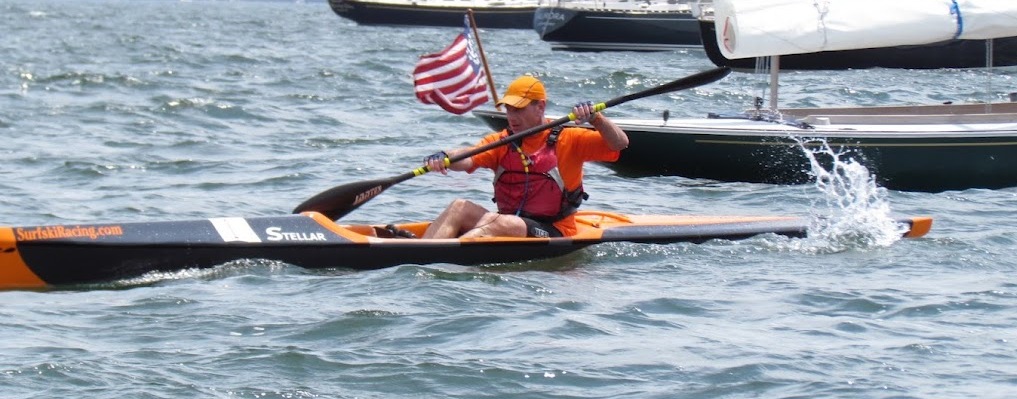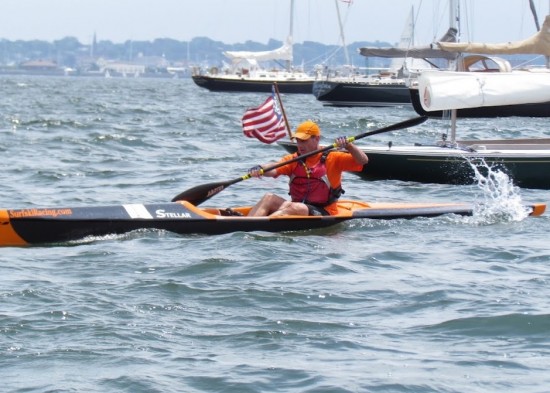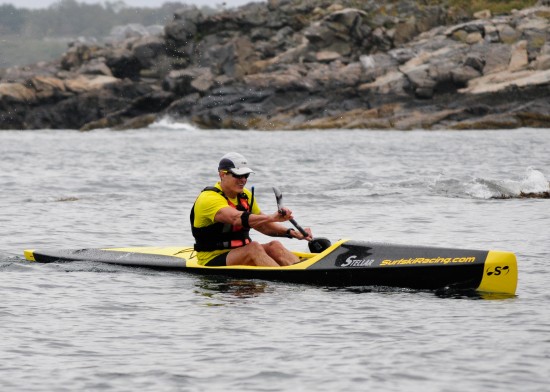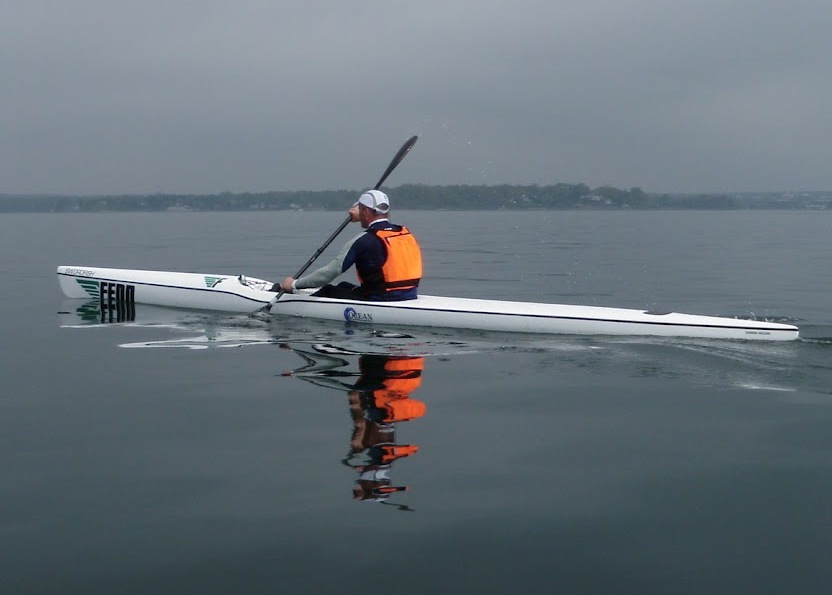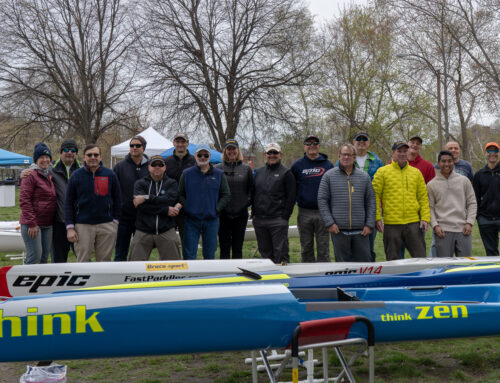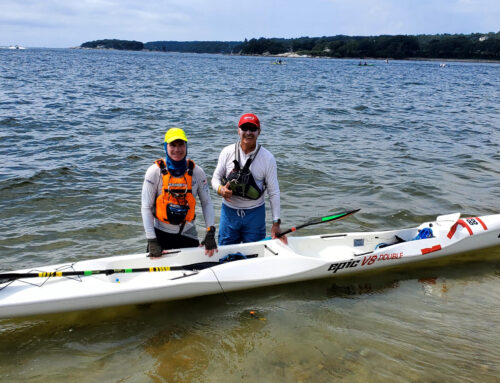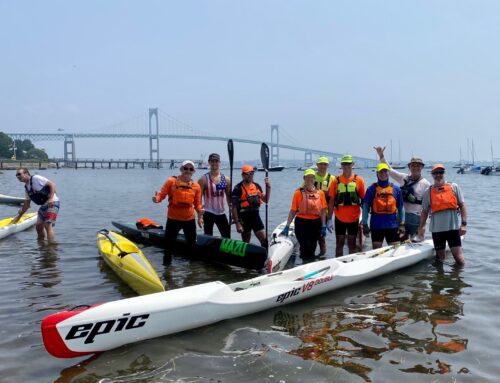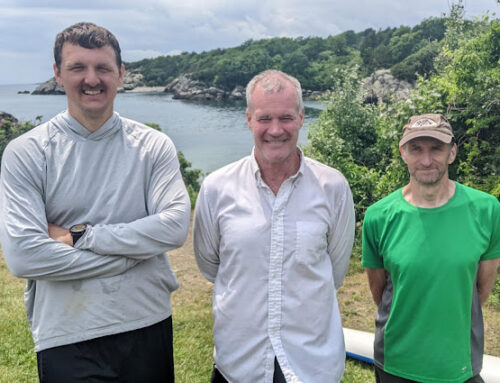Leg Drive: My experience is that the term ‘heel drive’ is a relative term to get paddlers comfortable with using leg drive. It is easy for newer paddlers to envision using “Heel drive” and for instructors to possibly teach it this way. Those of us who paddle surfskis as our primary boat in both flat water and ocean learn with practice, to use not only the heel, but as much of the foot as possible to generate power. The differences from one paddler to another is based on the following:
1. Skill level: rough water paddlers can generate more leg drive relative to non-rough water paddlers due to their stability in their surf skis. Paddlers having problems with stability have limited leg drive if any, and use more arms as the conditions become more unstable for them and lose confidence in focusing on leg drive. Rough water paddlers can generate leg drive in all conditions since stability is a non-factor. So less skilled paddlers often do better with more stable boats where they too can generate more power and are faster in more stable skis increasing their confidence and often their technique. Remember novice paddlers must be reminded to keep Equal but constant pressure on the toe pedals to keep the rudder from moving. When you want to turn you apply more pressure on the pedal while keeping some pressure on the other pedal. You do not want your rudder to flop around.
2. Proper setup in a ski is crucial. Different skis have differently designed footplates and toe pedals. Make sure the angle of the toe pedals is not too relaxed or straight up and down. You want good rudder control with just the right amount of toe pedal input.
3. Steering components like rudder lines from spectra to cable in varying models all have different tensions that require getting used to by adjusting to your comfort level. Toe pedal adjustment is critical here. A too far forward angle and you have less drive, too far angled back and lose some responsiveness.
4. Also some skis have a more relaxed footplate (Stellars) to more straight up and down like the Fenns. To each his own here, whatever is most comfortable for the paddler.
5. Most skis have different rudders that contribute to the varying amounts of rudder input to keep the boat tracking. If you are constantly giving too much input on the pedals, you do not have the proper set. Too much input takes away from leg drive.
6. Just as important is the ergonomics of the cockpit of each ski. They can vary greatly contributing to better leg drive or not. For instance, what is the height relationship of the bucket to the footwell? does hump impede leg drive, is a cockpit designed to keep your knees close together, or do you need some padding in the calf area? How high are your knees? are they too high, too low for maximum leg drive in the particular ski you are paddling in. What is good for one paddler in the same ski may not be ideal for you based on your leg length and skill level.
7. Are you secure in your seat? Too tight, too loose? We all talk about rotation. What does this really mean? Is you but rotating in the seat? Is your core rotating? Are your shoulders rotating? Leg drive affects rotation since pressure on the footplate is key to a nice rotation.
8. What type of shoes are you wearing? I adjust my footplate and pedals depending on summer or winter surfski paddling shoes.
9. Is your footstrap adjusted to suit your needs, do you prefer single or double foot straps. The foot strap needs to be snug to help with toe pedal pressure and a feeling of being more connected to the ski. Remember the contact points in a ski? The footplate is obviously one of them. You don’t want the strap to be too snug where you can’t get your foot out or it is impeding sliding your foot under it when remounting.
So all these are points of consideration that most of us figure out on our own or with a knowledgeable paddling buddy, or have the good fortune to take proper surfski lessons with knowledgeable coaches in your area.
Leg Drive: My experience is that the term ‘heel drive’ is a relative term to get paddlers comfortable with using leg drive. It is easy for newer paddlers to envision using “Heel drive” and for instructors to possibly teach it this way. Those of us who paddle surfskis as our primary boat in both flat water and ocean learn with practice, to use not only the heel, but as much of the foot as possible to generate power. The differences from one paddler to another is based on the following:
1. Skill level: rough water paddlers can generate more leg drive relative to non-rough water paddlers due to their stability in their surf skis. Paddlers having problems with stability have limited leg drive if any, and use more arms as the conditions become more unstable for them and lose confidence in focusing on leg drive. Rough water paddlers can generate leg drive in all conditions since stability is a non-factor. So less skilled paddlers often do better with more stable boats where they too can generate more power and are faster in more stable skis increasing their confidence and often their technique. Remember novice paddlers must be reminded to keep Equal but constant pressure on the toe pedals to keep the rudder from moving. When you want to turn you apply more pressure on the pedal while keeping some pressure on the other pedal. You do not want your rudder to flop around.
2. Proper setup in a ski is crucial. Different skis have differently designed footplates and toe pedals. Make sure the angle of the toe pedals is not too relaxed or straight up and down. You want good rudder control with just the right amount of toe pedal input.
3. Steering components like rudder lines from spectra to cable in varying models all have different tensions that require getting used to by adjusting to your comfort level. Toe pedal adjustment is critical here. A too far forward angle and you have less drive, too far angled back and lose some responsiveness.
4. Also some skis have a more relaxed footplate (Stellars) to more straight up and down like the Fenns. To each his own here, whatever is most comfortable for the paddler.
5. Most skis have different rudders that contribute to the varying amounts of rudder input to keep the boat tracking. If you are constantly giving too much input on the pedals, you do not have the proper set. Too much input takes away from leg drive.
6. Just as important is the ergonomics of the cockpit of each ski. They can vary greatly contributing to better leg drive or not. For instance, what is the height relationship of the bucket to the footwell? does hump impede leg drive, is a cockpit designed to keep your knees close together, or do you need some padding in the calf area? How high are your knees? are they too high, too low for maximum leg drive in the particular ski you are paddling in. What is good for one paddler in the same ski may not be ideal for you based on your leg length and skill level.
7. Are you secure in your seat? Too tight, too loose? We all talk about rotation. What does this really mean? Is you but rotating in the seat? Is your core rotating? Are your shoulders rotating? Leg drive affects rotation since pressure on the footplate is key to a nice rotation.
8. What type of shoes are you wearing? I adjust my footplate and pedals depending on summer or winter surfski paddling shoes.
9. Is your footstrap adjusted to suit your needs, do you prefer single or double foot straps. The foot strap needs to be snug to help with toe pedal pressure and a feeling of being more connected to the ski. Remember the contact points in a ski? The footplate is obviously one of them. You don’t want the strap to be too snug where you can’t get your foot out or it is impeding sliding your foot under it when remounting.
So all these are points of consideration that most of us figure out on our own or with a knowledgeable paddling buddy, or have the good fortune to take proper surfski lessons with knowledgeable coaches in your area.
Leg Drive: My experience is that the term ‘heel drive’ is a relative term to get paddlers comfortable with using leg drive. It is easy for newer paddlers to envision using “Heel drive” and for instructors to possibly teach it this way. Those of us who paddle surfskis as our primary boat in both flat water and ocean learn with practice, to use not only the heel, but as much of the foot as possible to generate power. The differences from one paddler to another is based on the following:
1. Skill level: rough water paddlers can generate more leg drive relative to non-rough water paddlers due to their stability in their surf skis. Paddlers having problems with stability have limited leg drive if any, and use more arms as the conditions become more unstable for them and lose confidence in focusing on leg drive. Rough water paddlers can generate leg drive in all conditions since stability is a non-factor. So less skilled paddlers often do better with more stable boats where they too can generate more power and are faster in more stable skis increasing their confidence and often their technique. Remember novice paddlers must be reminded to keep Equal but constant pressure on the toe pedals to keep the rudder from moving. When you want to turn you apply more pressure on the pedal while keeping some pressure on the other pedal. You do not want your rudder to flop around.
2. Proper setup in a ski is crucial. Different skis have differently designed footplates and toe pedals. Make sure the angle of the toe pedals is not too relaxed or straight up and down. You want good rudder control with just the right amount of toe pedal input.
3. Steering components like rudder lines from spectra to cable in varying models all have different tensions that require getting used to by adjusting to your comfort level. Toe pedal adjustment is critical here. A too far forward angle and you have less drive, too far angled back and lose some responsiveness.
4. Also some skis have a more relaxed footplate (Stellars) to more straight up and down like the Fenns. To each his own here, whatever is most comfortable for the paddler.
5. Most skis have different rudders that contribute to the varying amounts of rudder input to keep the boat tracking. If you are constantly giving too much input on the pedals, you do not have the proper set. Too much input takes away from leg drive.
6. Just as important is the ergonomics of the cockpit of each ski. They can vary greatly contributing to better leg drive or not. For instance, what is the height relationship of the bucket to the footwell? does hump impede leg drive, is a cockpit designed to keep your knees close together, or do you need some padding in the calf area? How high are your knees? are they too high, too low for maximum leg drive in the particular ski you are paddling in. What is good for one paddler in the same ski may not be ideal for you based on your leg length and skill level.
7. Are you secure in your seat? Too tight, too loose? We all talk about rotation. What does this really mean? Is you but rotating in the seat? Is your core rotating? Are your shoulders rotating? Leg drive affects rotation since pressure on the footplate is key to a nice rotation.
8. What type of shoes are you wearing? I adjust my footplate and pedals depending on summer or winter surfski paddling shoes.
9. Is your footstrap adjusted to suit your needs, do you prefer single or double foot straps. The foot strap needs to be snug to help with toe pedal pressure and a feeling of being more connected to the ski. Remember the contact points in a ski? The footplate is obviously one of them. You don’t want the strap to be too snug where you can’t get your foot out or it is impeding sliding your foot under it when remounting.
So all these are points of consideration that most of us figure out on our own or with a knowledgeable paddling buddy, or have the good fortune to take proper surfski lessons with knowledgeable coaches in your area.
Leg Drive: My experience is that the term ‘heel drive’ is a relative term to get paddlers comfortable with using leg drive. It is easy for newer paddlers to envision using “Heel drive” and for instructors to possibly teach it this way. Those of us who paddle surfskis as our primary boat in both flat water and ocean learn with practice, to use not only the heel, but as much of the foot as possible to generate power. The differences from one paddler to another is based on the following:
1. Skill level: rough water paddlers can generate more leg drive relative to non-rough water paddlers due to their stability in their surf skis. Paddlers having problems with stability have limited leg drive if any, and use more arms as the conditions become more unstable for them and lose confidence in focusing on leg drive. Rough water paddlers can generate leg drive in all conditions since stability is a non-factor. So less skilled paddlers often do better with more stable boats where they too can generate more power and are faster in more stable skis increasing their confidence and often their technique. Remember novice paddlers must be reminded to keep Equal but constant pressure on the toe pedals to keep the rudder from moving. When you want to turn you apply more pressure on the pedal while keeping some pressure on the other pedal. You do not want your rudder to flop around.
2. Proper setup in a ski is crucial. Different skis have differently designed footplates and toe pedals. Make sure the angle of the toe pedals is not too relaxed or straight up and down. You want good rudder control with just the right amount of toe pedal input.
3. Steering components like rudder lines from spectra to cable in varying models all have different tensions that require getting used to by adjusting to your comfort level. Toe pedal adjustment is critical here. A too far forward angle and you have less drive, too far angled back and lose some responsiveness.
4. Also some skis have a more relaxed footplate (Stellars) to more straight up and down like the Fenns. To each his own here, whatever is most comfortable for the paddler.
5. Most skis have different rudders that contribute to the varying amounts of rudder input to keep the boat tracking. If you are constantly giving too much input on the pedals, you do not have the proper set. Too much input takes away from leg drive.
6. Just as important is the ergonomics of the cockpit of each ski. They can vary greatly contributing to better leg drive or not. For instance, what is the height relationship of the bucket to the footwell? does hump impede leg drive, is a cockpit designed to keep your knees close together, or do you need some padding in the calf area? How high are your knees? are they too high, too low for maximum leg drive in the particular ski you are paddling in. What is good for one paddler in the same ski may not be ideal for you based on your leg length and skill level.
7. Are you secure in your seat? Too tight, too loose? We all talk about rotation. What does this really mean? Is you but rotating in the seat? Is your core rotating? Are your shoulders rotating? Leg drive affects rotation since pressure on the footplate is key to a nice rotation.
8. What type of shoes are you wearing? I adjust my footplate and pedals depending on summer or winter surfski paddling shoes.
9. Is your footstrap adjusted to suit your needs, do you prefer single or double foot straps. The foot strap needs to be snug to help with toe pedal pressure and a feeling of being more connected to the ski. Remember the contact points in a ski? The footplate is obviously one of them. You don’t want the strap to be too snug where you can’t get your foot out or it is impeding sliding your foot under it when remounting.
So all these are points of consideration that most of us figure out on our own or with a knowledgeable paddling buddy, or have the good fortune to take proper surfski lessons with knowledgeable coaches in your area.
Leg Drive: My experience is that the term ‘heel drive’ is a relative term to get paddlers comfortable with using leg drive. It is easy for newer paddlers to envision using “Heel drive” and for instructors to possibly teach it this way. Those of us who paddle surfskis as our primary boat in both flat water and ocean learn with practice, to use not only the heel, but as much of the foot as possible to generate power. The differences from one paddler to another is based on the following:
1. Skill level: rough water paddlers can generate more leg drive relative to non-rough water paddlers due to their stability in their surf skis. Paddlers having problems with stability have limited leg drive if any, and use more arms as the conditions become more unstable for them and lose confidence in focusing on leg drive. Rough water paddlers can generate leg drive in all conditions since stability is a non-factor. So less skilled paddlers often do better with more stable boats where they too can generate more power and are faster in more stable skis increasing their confidence and often their technique. Remember novice paddlers must be reminded to keep Equal but constant pressure on the toe pedals to keep the rudder from moving. When you want to turn you apply more pressure on the pedal while keeping some pressure on the other pedal. You do not want your rudder to flop around.
2. Proper setup in a ski is crucial. Different skis have differently designed footplates and toe pedals. Make sure the angle of the toe pedals is not too relaxed or straight up and down. You want good rudder control with just the right amount of toe pedal input.
3. Steering components like rudder lines from spectra to cable in varying models all have different tensions that require getting used to by adjusting to your comfort level. Toe pedal adjustment is critical here. A too far forward angle and you have less drive, too far angled back and lose some responsiveness.
4. Also some skis have a more relaxed footplate (Stellars) to more straight up and down like the Fenns. To each his own here, whatever is most comfortable for the paddler.
5. Most skis have different rudders that contribute to the varying amounts of rudder input to keep the boat tracking. If you are constantly giving too much input on the pedals, you do not have the proper set. Too much input takes away from leg drive.
6. Just as important is the ergonomics of the cockpit of each ski. They can vary greatly contributing to better leg drive or not. For instance, what is the height relationship of the bucket to the footwell? does hump impede leg drive, is a cockpit designed to keep your knees close together, or do you need some padding in the calf area? How high are your knees? are they too high, too low for maximum leg drive in the particular ski you are paddling in. What is good for one paddler in the same ski may not be ideal for you based on your leg length and skill level.
7. Are you secure in your seat? Too tight, too loose? We all talk about rotation. What does this really mean? Is you but rotating in the seat? Is your core rotating? Are your shoulders rotating? Leg drive affects rotation since pressure on the footplate is key to a nice rotation.
8. What type of shoes are you wearing? I adjust my footplate and pedals depending on summer or winter surfski paddling shoes.
9. Is your footstrap adjusted to suit your needs, do you prefer single or double foot straps. The foot strap needs to be snug to help with toe pedal pressure and a feeling of being more connected to the ski. Remember the contact points in a ski? The footplate is obviously one of them. You don’t want the strap to be too snug where you can’t get your foot out or it is impeding sliding your foot under it when remounting.
So all these are points of consideration that most of us figure out on our own or with a knowledgeable paddling buddy, or have the good fortune to take proper surfski lessons with knowledgeable coaches in your area.
Leg Drive: My experience is that the term ‘heel drive’ is a relative term to get paddlers comfortable with using leg drive. It is easy for newer paddlers to envision using “Heel drive” and for instructors to possibly teach it this way. Those of us who paddle surfskis as our primary boat in both flat water and ocean learn with practice, to use not only the heel, but as much of the foot as possible to generate power. The differences from one paddler to another is based on the following:
1. Skill level: rough water paddlers can generate more leg drive relative to non-rough water paddlers due to their stability in their surf skis. Paddlers having problems with stability have limited leg drive if any, and use more arms as the conditions become more unstable for them and lose confidence in focusing on leg drive. Rough water paddlers can generate leg drive in all conditions since stability is a non-factor. So less skilled paddlers often do better with more stable boats where they too can generate more power and are faster in more stable skis increasing their confidence and often their technique. Remember novice paddlers must be reminded to keep Equal but constant pressure on the toe pedals to keep the rudder from moving. When you want to turn you apply more pressure on the pedal while keeping some pressure on the other pedal. You do not want your rudder to flop around.
2. Proper setup in a ski is crucial. Different skis have differently designed footplates and toe pedals. Make sure the angle of the toe pedals is not too relaxed or straight up and down. You want good rudder control with just the right amount of toe pedal input.
3. Steering components like rudder lines from spectra to cable in varying models all have different tensions that require getting used to by adjusting to your comfort level. Toe pedal adjustment is critical here. A too far forward angle and you have less drive, too far angled back and lose some responsiveness.
4. Also some skis have a more relaxed footplate (Stellars) to more straight up and down like the Fenns. To each his own here, whatever is most comfortable for the paddler.
5. Most skis have different rudders that contribute to the varying amounts of rudder input to keep the boat tracking. If you are constantly giving too much input on the pedals, you do not have the proper set. Too much input takes away from leg drive.
6. Just as important is the ergonomics of the cockpit of each ski. They can vary greatly contributing to better leg drive or not. For instance, what is the height relationship of the bucket to the footwell? does hump impede leg drive, is a cockpit designed to keep your knees close together, or do you need some padding in the calf area? How high are your knees? are they too high, too low for maximum leg drive in the particular ski you are paddling in. What is good for one paddler in the same ski may not be ideal for you based on your leg length and skill level.
7. Are you secure in your seat? Too tight, too loose? We all talk about rotation. What does this really mean? Is you but rotating in the seat? Is your core rotating? Are your shoulders rotating? Leg drive affects rotation since pressure on the footplate is key to a nice rotation.
8. What type of shoes are you wearing? I adjust my footplate and pedals depending on summer or winter surfski paddling shoes.
9. Is your footstrap adjusted to suit your needs, do you prefer single or double foot straps. The foot strap needs to be snug to help with toe pedal pressure and a feeling of being more connected to the ski. Remember the contact points in a ski? The footplate is obviously one of them. You don’t want the strap to be too snug where you can’t get your foot out or it is impeding sliding your foot under it when remounting.
So all these are points of consideration that most of us figure out on our own or with a knowledgeable paddling buddy, or have the good fortune to take proper surfski lessons with knowledgeable coaches in your area.
